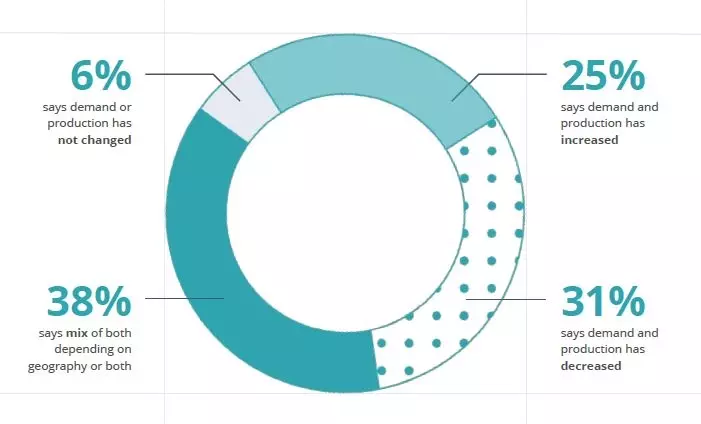Do you know what manufacturing executives are most worried about today?
Market uncertainty: 64% of manufacturing executives say it’s their biggest concern1. Given the state of the economy amidst a continuing public health crisis, this shouldn’t be a surprise. The volatility of the market inevitably impacts manufacturing, a fact that business leaders are keenly aware of, yet ultimately possess limited ability to influence.
Which is why manufacturing leadership must focus on what he/she can influence and control – how their organization adapts and responds to disruption and uncertainty.
This is the second in a three-part blog series to discuss how manufacturers can drive business continuity now and into the future, by considering three guiding principles:
1. Accommodating the new employee experience
2. Enabling continuous operational agility
3. Fueling lasting financial resiliency
Today, we focus on the second principle, enabling continuous operational agility.
New complexities are forcing manufacturers to adapt practices and processes to meet current challenges while preparing for an uncertain future. Leveraging workforce management tools can help manufacturers nimbly adapt to a fluid business environment. Let’s review a few examples of how technology can help manufacturers in their continued efforts to:
1. Meet shifting production demands while adhering to new safety considerations
94% of manufacturers have experienced a change in demand during the past few months, and with continuing market volatility, more change may occur.

Source: The State of Manufacturing by Oden Technologies
To adapt to such fluctuations, manufacturers must optimize production schedules and maximize labor resources. This is a challenge during “normal” business conditions, considering all of the factors that go into employee scheduling – the availability of workers with required skillsets, compliance with overtime regulations, or union rules around seniority, etc. Now enter the pandemic. Add safety protocols like meeting social distancing guidelines or implementing enhanced sanitization procedures. Not to mention constraints on labor availability due to illness, quarantine status, furloughs or lay-offs.
Workforce scheduling technology streamlines the process for making adaptations to production and shift schedules which meet demand and address safety considerations. For example, schedules which accommodate social distancing can easily be created by scheduling employees into teams or groups. Shift patterns can be quickly modified to add extra time between shifts for sanitization. Staggering shift start and end times to reduce foot traffic at the door (or timeclock).
Scheduling software can do all of this, and put the right people in the right job, matching skill supply with production demand while accounting for any regulatory, union or company-defined scheduling policies by automatically applying such rules when aligning an employee to a shift.
2. Adapt policies and comply with new and shifting regulatory requirements
Speaking of corporate policies and regulatory compliance, manufacturers have contended with a number of changes in this area. In March, the Department of Labor announced the Families First Coronavirus Response Act (FFCRA), which expanded the FMLA. At the same time, many manufacturers amended their own corporate leave or sick policies for if/when employees need to take time-off in the case of illness, to quarantine, or to care for loved ones.
Complying with new policies and FMLA expansions adds enhanced complexity to what many already consider an administrative headache for HR, with extensive side effects often felt by operations.
Workforce management software can help alleviate the pain by making it easy to implement policy changes or additions, simplify the process for determining leave eligibility, provide easy-to-use tools to manage leave requests and open leave cases, and much more. Digital absence management solutions can help manufacturers efficiently manage leave and time off programs and adhere to changing regulations while minimizing the operational impact.
3. Deploy and flex labor to adapt to the unexpected
Ultimately, the key to operational agility comes down to visibility. It’s impossible to react quickly to what cannot be seen. In today’s dynamic environment, which is full of disruption, providing managers with access to information to drive faster and more effective decision making is a necessity. Managers also need digital tools which enable them to act on such decisions.
Workforce management technology delivers real-time operational labor data to manufacturers. From an interactive dashboard, managers can manage their entire operation from any device, from anywhere – on the plant floor, in the office, or remotely from home. Digital tools enable managers to quickly react to the unexpected, such as finding a replacement when an employee calls out sick, or reallocating skilled staff when raw materials are delayed due to supply chain issues.
The Takeaway
With digital tools to automate employee scheduling practices, support compliance, and provide real-time visibility to operational labor data, manufacturers can enable continuous operational agility to improve productivity, increase labor utilization, and reduce risk while supporting workplace safety, despite market uncertainty.
Learn how UKG can help your manufacturing organization drive business continuity.
Source: 1. https://info.oden.io/the-state-of-manufacturing-2020-ceo-insights-report



